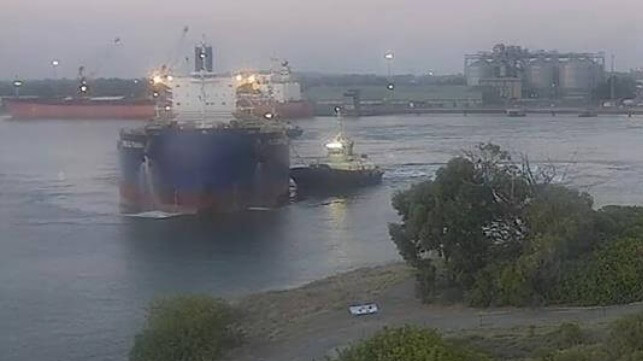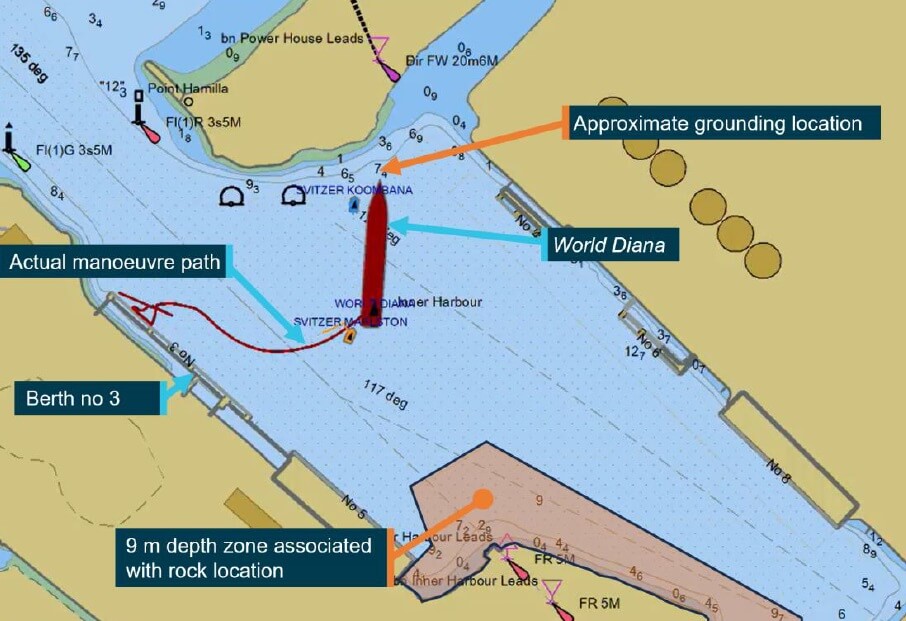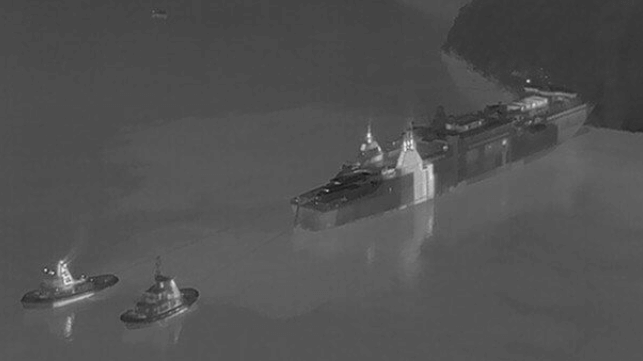ATSB: Pilot Error, Lack of Procedure Caused Bulker's Grounding

Ineffective pilotage and port deficiencies caused the grounding of a bulk carrier last year, the Australian Transport Safety Bureau (ATSB) has determined.
In its final report on the grounding of the World Diana at the Port of Bunbury in April 2023, ATSB contends that ineffective bridge resource management was largely to blame for the incident. The port authority also came in for criticism: at the time, it had not developed adequate procedures for arrival and departure plans for larger ships, ATSB said.
On the morning of April 22, 2023, World Diana was scheduled to depart the Port of Bunbury with the assistance of a harbor pilot. The ship was berthed starboard side to at the number three berth, and needed to be maneuvered into the inner harbor turning basin and then turned to port towards the harbor entrance. It was nearly fully laden with a cargo of grain, destined for the Port of Kosichang in Thailand via the Singapore Strait.
The 81,200 dwt, 229-meter ship had a crew of 19. The pilot had completed about 4,000 pilotage movements at the port of Bunbury, including about 35 vessels of over 200 meters.
Beginning at 0542 local time, the pilot conducted a master-pilot exchange on the bridge. The departure plan called for two tugs to help the ship turn around and sail out of the harbor. At 0632, when all the mooring lines had been cast off, the pilot instructed both tug masters to ‘lift off’ using quarter power and, shortly after, asked them to increase to half power. Four minutes later the ship had developed slight headway with its main engine running dead slow ahead.
As the 2020-build Panamax bulker turned, its headway increased. By 0641, the ship’s bow was closing on the shallow water on the eastern side of the harbor. Two minutes later the bulker’s bow grounded on the bank and its speed rapidly reduced to zero. The pilot then maneuvered the ship astern using its propulsion and the tugs. Once the ship was established in the center of the turning basin, the turn was completed.
“This turn was started earlier than planned, reducing the amount of room available. The ship’s speed was then allowed to increase until there was no room to safely turn, and the bow of the ship grounded on a shallow bank to the east of the harbor entrance,” said Angus Mitchell, ATSB Chief Commissioner.
The investigation established that at the time of the incident, a pilot transfer vessel inspected the shallow area but did not identify any evidence of a grounding therefore it was believed to have been a near miss. There was no inspection of the ship’s hull carried out prior to departing Australia. The pilot and ship’s master continued the departure and the pilot disembarked the ship outside the outer harbor.
But two days later the pilot reported the incident as a near miss with a subsequent review of incident data indicating a grounding. A survey of the seabed in the incident location also identified an indentation in the soft seabed where World Diana’s bow had grounded.
The ship’s managers were made aware of the grounding, with an underwater hull inspection that was conducted on May 1 identifying minor contact damage of the shell plating of the fore peak tank. The ship was cleared to continue trading with the damage to be attended at its next scheduled dry docking in 2025.
In its findings, the ATSB determined that World Diana's turn to port to depart the inner harbor was started earlier than planned, reducing available room to complete the turn. Once the turn began, the ship’s speed was allowed to increase until there was no space left, and the ship ran aground.

Courtesy ATSB
The investigators also determined that the Port of Bunbury had not developed adequate arrival and departure plan procedures for larger ships that were berthed starboard side alongside berth number three. In effect, this increased the risk of grounding.
The Southern Port Authority has since updated its marine pilotage standards and procedures for Bunbury with standard procedures for departing all berths. A maximum rate of turn for turning ships in the harbor has also been specified.
Report: NZ Ferry Ran Aground Because Autopilot Was Turned On Too Early

The ferry Aratere may have gone aground because the crew accidentally engaged the autopilot, according to an internal safety memo, written by the ferry operator after the casualty and leaked to New Zealand media outlets.
The 18,000 GT ferry Aratere departed the port of Picton on the evening of June 21 for its fourth and final transit of the day. At about 2145 hours, about half an hour after leaving her berth, Aratere went hard aground at a position about 1.5 nautical miles to the north of Picton in Titoko Bay. No flooding or pollution were reported, and the 39 crewmembers and a team of eight professional divers on board were unharmed. They spent the night aboard the ship, and the vessel was refloated with local tug assistance the following evening.
According to the internal bulletin, which was distributed other mariners in the operator's fleet to alert them to a potential safety risk, an early investigation shows that a string of errors related to steering control led to the grounding. Aratere was passing Mabel Island, just a mile from her point of departure, when a watchstander switched over from hand steering to autopilot and then "inadvertently pressed" the "execute" button on the starboard multipilot console. This automatic steering control system had been recently installed.
The accidental engagement of autopilot initiated a turn about one nautical mile too "early" and resulted in an unplanned deviation from course, according to the bulletin. The crew identified the error but were unable to recover in time to prevent a grounding on the shores of Titoki Bay.
Investigators are still looking into why the crew could not recover hand steering in time to avert a grounding, but it took approximately one minute for the autopilot to be disengaged, according to the leaked memo.
The reason for the "inadvertent" engagement has not been formally determined, but political party New Zealand First alleged this week that a crewmember turned the autopilot on and then "went for a cup of coffee." NZ Acting Deputy Prime Minister Winston Peters has called on operator KiwiRail to immediately confirm details of the casualty, without waiting for the outcome of an ongoing investigation. "You can say I'm asking KiwiRail [to] front up - right here right now," he told NZ outlet Stuff. "We don't need a month-long inquiry or three or four months while they try and do PR and damage control."
KiwiRail subsidiary Interislander has vigorously denied New Zealand First's claims, saying that the bridge was properly attended at all times and that there were no attempts to minimize publicity after the casualty.
No comments:
Post a Comment